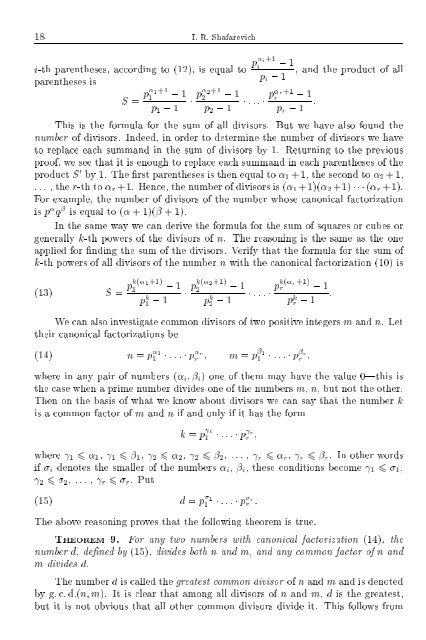SELECTED CHAPTERS FROM ALGEBRA I. R. Shafarevich Preface
SELECTED CHAPTERS FROM ALGEBRA I. R. Shafarevich Preface
SELECTED CHAPTERS FROM ALGEBRA I. R. Shafarevich Preface
You also want an ePaper? Increase the reach of your titles
YUMPU automatically turns print PDFs into web optimized ePapers that Google loves.
18 I. R. <strong>Shafarevich</strong>i-th parentheses, according to (12), is equal to pi+1 ; 1i, and the product of allp i ; 1parentheses isS = p1+1 1; 1 p2+1 2; 1 ... pr+1 r; 1p 1 ; 1 p 2 ; 1 p r ; 1 :This is the formula for the sum of all divisors. But we have also found thenumber of divisors. Indeed, in order to determine the number of divisors we haveto replace each summand in the sum of divisors by 1. Returning to the previousproof, we see that it is enough to replace each summand in each parentheses of theproduct S 0 by1. The rst parentheses is then equal to 1 + 1, the second to 2 +1,. . . , the r-th to r +1. Hence, the number of divisors is ( 1 +1)( 2 +1)( r +1).For example, the number of divisors of the number whose canonical factorizationis p q is equal to ( +1)( +1).In the same way we can derive the formula for the sum of squares or cubes orgenerally k-th powers of the divisors of n. The reasoning is the same as the oneapplied for nding the sum of the divisors. Verify that the formula for the sum ofk-th powers of all divisors of the number n with the canonical factorization (10) is(13) S = pk(1+1) 1; 1p k 1 ; 1 pk(2+1) 2; 1p k 2 ; 1 ... pk(r+1)r ; 1p k ; 1 :rWe can also investigate common divisors of two positive integers m and n. Lettheir canonical factorizations be(14) n = p 11 ... prr m = p1 1 ... pr rwhere in any pair of numbers ( i i ) one of them may have thevalue 0|this isthe case when a prime number divides one of the numbers m, n, but not the other.Then on the basis of what we know about divisors we can say that the number kis a common factor of m and n if and only if it has the formk = p 11 ... prrwhere 1 6 1 , 1 6 1 , 2 6 2 , 2 6 2 , ... , r 6 r , r 6 r . In other wordsif i denotes the smaller of the numbers i , i , these conditions become 1 6 1 , 2 6 2 , ... , r 6 r . Put(15) d = p 11 ... prr:The above reasoning proves that the following theorem is true.THEOREM 9. For any two numbers with canonical factorization (14), thenumber d, denedby(15), divides both n and m, and any common factor of n andm divides d.The number d is called the greatest common divisor of n and m and is denotedby g: c: d:(n m). It is clear that among all divisors of n and m, d is the greatest,but it is not obvious that all other common divisors divide it. This follows from
















